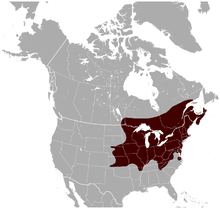Synaptomys cooperi
| Southern bog lemming | |
|---|---|
 |
|
| Scientific classification | |
| Kingdom: | Animalia |
| Phylum: | Chordata |
| Class: | Mammalia |
| Order: | Rodentia |
| Family: | Cricetidae |
| Genus: | Synaptomys |
| Species: | S. cooperi |
| Binomial name | |
|
Synaptomys cooperi (Baird, 1857) |
|
 |
|
| Southern Bog Lemming range | |
The southern bog lemming (Synaptomys cooperi) is a small North American lemming. Its range overlaps with the other species in genus Synaptomys, the northern bog lemming, in southeastern Canada but extends further south.
The southern bog lemmings are a type of small voles. They are covered with thick brownish fur on the back ranges in color from reddish to dark brown and have a grizzled appearance. The belly is silver-gray. The shallow grooved upper incisors and a relatively shorter tail distinguish this species from other voles. They have relatively large head and small eyes. The ears barely show through puffy head fur. The southern bog lemmings have 4 toes and 1 small, nailed thumb on the forefeet and 5 toes on the hind feet. Females have 6 mammary glands, which distinguishes this species from its closest relative, northern bog lemmings, which have 8 mammary glands. They have round thick bodies covered with grey-brown fur with silver grey underparts. They have a large head, short legs and a short tail which is lighter underneath. Their small ears are barely visible through their fur. Their upper incisors are grooved. They are 13 centimetres (5.1 in) long with a 2 centimetres (0.79 in) tail and weigh about 35 grams (1.2 oz).
Southern bog lemmings are found in eastern North America, from southern Quebec and Manitoba in Canada to western Minnesota, to southwestern Kansas, and east to the Atlantic coast of the United States. This species is more common in deciduous and mixed coniferous –deciduous forests. The grassy openings and edges of these forests, especially where sedges, ferns and shrubs grow and when the soil is loose and crumbly, are habitats the bog lemming prefers. It also inhibits wetter and drier sites when meadow voles are scarce or absent. The southern bog lemmings create a maze of interconnecting tunnels and runways and build nests from plant fibers. Summer nests are on the surface of the ground or in a clump of sedges or grasses but winter nests are usually underground in an enlarged tunnel. These animals are found in mixed forests, wetlands and grasslands in eastern North America.
Fresh vegetation, especially the leaves, stems, seeds heads and roots of grasses and sedges is the main food of this species. Raspberries, blueberries and other fruits, insects, fungi and bark form a lesser part of the diet. They cache grasses and sedge stems in underground chambers. The southern bog lemmings are more active during night .They don’t hibernate. They live in groups of a few to several dozen individuals. Female lemmings have 2 or 3 litters of 4 to 6 young in a year. The young are born in a nest in an underground burrow or concealed in vegetation. Most will live less than a year. The range of these animals is thought to be declining in some areas due to loss of wetland habitat.
...
Wikipedia

